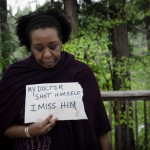Greater discontinuity equals greater dissatisfaction.
On Wednesday afternoon, one of the residents stopped in my office to talk about a patient he had just gotten off the phone with. It was a patient of his who had asthma and a recent upper respiratory tract infection for which she had received treatment at an urgent care center with an oral antibiotic and a course of steroids.
She told him that she was still feeling poorly, had some lingering cough, and wanted to come and see him to make sure she had been treated correctly and find out why she was still coughing.
He told me he had no openings available on his schedule until Monday, and did I think she could wait until then, or should he have her come see a different resident or the nurse practitioner over the next 2 days, before the weekend.
He seemed sort of shocked when I suggested that maybe he add her on his schedule during his next practice session.
After I explained to him that the relatively high no-show rate among our practice might leave him with some available time during that practice session, and that should he be overwhelmed with a large number of complex patients, we would likely be able to find another provider with an opening to see one of the several interim visits on his schedule, he actually came around to the idea of being able to see his own patient for an urgent visit. Even as an overbook.
A sick visit like this was probably not going to add much to his day and might make her feel much better, even if the therapeutic intervention was only reassurance.
One of the new roles we’ve created for our patient-centered medical home is a coordination-of-care registrar, whose job is to scrub the schedules of all of our providers to see where appointment availability can be found and continuity can be recaptured.
We have seen innumerable examples in our practice where resident A is seeing resident B’s patient while resident B is seeing resident C’s patient (or even resident A’s patient) at the same time. And sometimes resident D is surfing the web, while resident E is swamped.
Patients who have not been seen in our practice for several years are put on a random doctor’s schedule for an “annual exam,” when their primary care provider has appointment availability the following week, or the following day.
Countless studies have shown that patient satisfaction and provider satisfaction increase dramatically with both access to care and continuity of care. Being able to see your provider matters.
The hallways of our practice are often packed during the afternoon with paramedics picking up patients to bring to the emergency room across the street. Granted, we have a very complex and often sick panel of patients, but I would wager that many of these patients are being sent over because the provider may not know that much about them, has never seen them before, and does not know what to make of a wide constellation of symptoms.
I will freely admit that there are patients who tell me they have chest pain who I am not sending to the emergency room. Shocking? Perhaps, but we all get a sense of our patients and learn through time and exposure and training to know when to react, and when not to over-react.
One of my credos for continuity scheduling is that we want to work towards a system where someone should see their primary care provider and no one else, unless there is some sort of critical, time-sensitive condition that warrants them being seen by someone who doesn’t know them. Or if this is absolutely positively the only time they could get off work or the babysitter could watch the kids.
I can foresee a time when our continuity registrar will be scouring the schedule, pulling patients from one provider and adding them to another, reshuffling appointments, freeing up appointment slots, overbooking patients, improving continuity and satisfaction across the board.
There certainly exists the possibility, and we do not want this to happen, that someone will be talked out of a more urgent appointment and made an inappropriate later follow-up with their continuity provider, and we need to make sure there are mechanisms in place to prevent this. Maybe that acute myocardial infarction can wait till next week when Dr. P has an opening in his schedule!
Otherwise, continuity counts.
Fred N. Pelzman is an associate professor of medicine, New York Presbyterian Hospital and associate director, Weill Cornell Internal Medicine Associates, New York City, NY. He blogs at Building the Patient-Centered Medical Home.















![Sibling advice for surviving the medical school marathon [PODCAST]](https://kevinmd.com/wp-content/uploads/Design-1-190x100.jpg)


![Leadership buy-in is the key to preventing burnout [PODCAST]](https://kevinmd.com/wp-content/uploads/Design-4-190x100.jpg)
